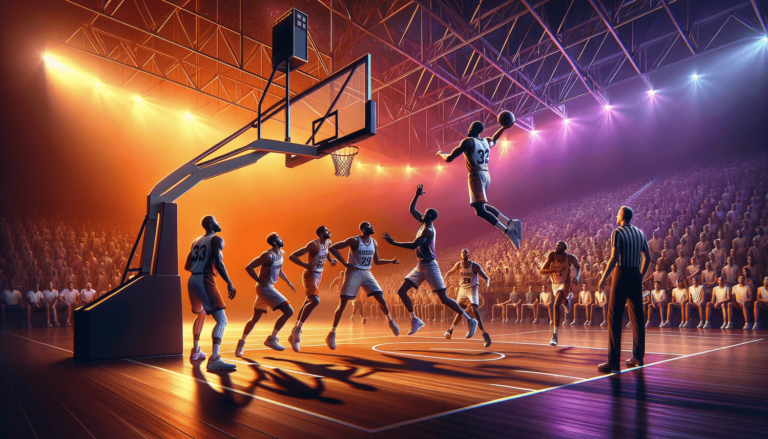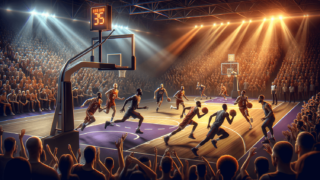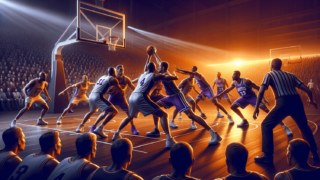
Over-and-Back Rule in Basketball
Written by: Basketball Universe
Last updated:

🏀 Buckle up, basketball enthusiasts! It’s time to take a deep dive into a rule that often leaves fans scratching their heads – the mystifying Over-and-Back Rule. This curious rule, that hovers between both ends of the court, shapes the game in ways we don’t always acknowledge. Whether you’re a hoops aficionado or someone who shouts “What just happened?” during a game, we’ve got your back. Join us as we dissect this lesser-known regulation and reveal how it impacts the mesmerizing world of basketball.
Over-and-Back Rule in Basketball
The Over-and-Back Rule in basketball is a violation that occurs when the offensive team has brought the ball across the half-court line (establishing frontcourt), and it then crosses back to the backcourt without being touched by a defensive player. In essence, once a team has advanced the ball past the half-court line, they cannot retreat to the backcourt. When this violation occurs, the opposing team is awarded possession of the ball.
Origins of the Over-and-Back Rule
Before we explain the ins and outs of the over-and-back rule, let’s take a step back and understand its origins. The rule was first introduced by the International Basketball Federation (FIBA) and later adopted by the NCAA and NBA. The purpose of this rule is to maintain the flow of the game while preventing teams from excessively stalling or running down the clock to their advantage.
The Mechanics of the Over-and-Back Rule
To fully grasp this rule, we must first understand some key concepts, such as frontcourt, backcourt, and team control, as these play a significant role when it comes to implementing the over-and-back rule.
Backcourt and Frontcourt
First, imagine a standard basketball court, divided into two even halves by a line known as the mid-court or half-court line. The half of the court where a team’s basket is located is known as the backcourt, while the remaining half is called the frontcourt.
Team Control
Team control refers to a situation in which a player of a specific team is holding, dribbling, or intentionally directing the movement of the ball. It’s important to note that a loose ball, like during a rebound attempt or a deflection, may not qualify as team control. Team control starts when a player gains control of the ball and ends when a shot is attempted or when the opposing team gains control of the ball.
Determining an Over-and-Back Violation
Now that we understand the fundamental concepts, let’s dive into the specific criteria that need to be met for an over-and-back violation to occur.
Crossing the Half-Court Line
An over-and-back violation can only happen when a team has established frontcourt presence. That means the ball and the player who possesses the ball must cross the half-court line entirely. Keep in mind that a violation cannot be called until both feet and the ball have crossed the half-court line.
The Ball Crosses Back Over the Line
Once a team has established frontcourt presence, an over-and-back violation will be called if the ball crosses back into the team’s backcourt without being touched by a defensive player. This can occur in various ways, such as a poor pass between offensive players, an offensive player losing control of the ball, or a bounce off a player’s foot.
Exceptions to the Rule
While the over-and-back rule may seem straightforward, there are a few exceptions that can prevent it from being called. These exceptions are crucial to understand as they can change the course of a game.
- Defensive Touch: If a defensive player touches the ball after a team has established frontcourt presence, and the ball ends up in the backcourt, an over-and-back violation is not called. Instead, the offensive team is allowed to recover the ball and continue the play.
- Loose Ball Scramble: In some cases, multiple players might be trying to secure a loose ball, and it may cross back to the backcourt in the process. If it’s deemed that no team has established control of the ball, an over-and-back violation will not be called.
- Jump Ball: If a held ball situation occurs and the resulting jump ball is tipped into a team’s backcourt, it is not considered an over-and-back violation.
Consequences of an Over-and-Back Violation
Now that we’ve covered the criteria and exceptions for the over-and-back rule, let’s discuss what happens when this violation is called during a game. An over-and-back violation results in the following consequences:
- Change of Possession: When an over-and-back violation is called, the team that committed the violation loses possession of the ball. The opposing team receives the ball at the nearest sideline or the point where the violation occurred.
- Reset of Shot Clock: Since basketball rules state that the shot clock does not reset for over-and-back violations, the team gaining possession will have the remainder of the shot clock (in professional leagues) or a new shot clock will start (in FIBA).
How the Over-and-Back Rule Affects Strategy
Understanding the over-and-back rule can lead to strategic advantages in various aspects of the game. From offense to defense, let’s explore how this rule can impact the game on both ends of the court.
Offensive Strategy
For the offensive team, the over-and-back rule is a reminder that they must take care of the ball in the frontcourt. Smart plays, communication between players, and precise passes are essential to avoid committing a costly violation. Additionally, teams must be aware of their positioning and avoid retreating towards the half-court line, which can lead to making unforced errors and give their opponent a scoring opportunity.
Defensive Strategy
On the defensive end, the over-and-back rule can be used to apply pressure that can force a violation. Defenders can try to push the offensive players towards the half-court line or use different tactics (e.g., traps or double teams) to force the ball handler into making a poor pass. Anticipation is key; defenders must read the play and position themselves accordingly to create opportunities for turnovers and easy scoring chances.
Over-and-Back Rule in Different Leagues
While the core idea remains the same, there can be slight variations in how the over-and-back rule is implemented across different basketball organizations. Some of the most notable organizations include FIBA, NBA, NCAA, and high school basketball.
FIBA
In FIBA basketball, the over-and-back rule is strictly enforced, with the shot clock reset only happening in specific situations. Generally, the shot clock does not reset, and the team gaining possession will have the remaining time on the shot clock to make an attempt.
NBA
The NBA follows similar guidelines as FIBA. The over-and-back rule is enforced, and the shot clock does not reset in most cases. However, if the defensive team creates the violation by deflecting or touching the ball, leading it to the offensive team’s backcourt, the shot clock will automatically reset to 14 seconds, regardless of the time that was remaining on the clock.
NCAA
Similar to other leagues, the NCAA also enforces the over-and-back rule. However, the shot clock resets to 20 seconds instead of 14 in certain situations, such as when the defensive team causes the ball to go into the backcourt.
High School Basketball
At the high school level, the over-and-back rule is followed to maintain the flow of the game. Depending on the region, the shot clock rules in high school basketball may vary, with some states not using a shot clock at all. In such cases, the team gaining possession simply has a new possession to work with.
Final Thoughts
As we have seen, the over-and-back rule in basketball provides structure to the game and encourages teams to play a more strategic and dynamic offense. Your knowledge of the basketball rules, such as the over-and-back rule, will not only make you a better player or coach, but also a more informed fan. Keep learning and enjoying the game that we all love!
Related Rules and Concepts
Now that you have a solid understanding of the over-and-back rule in basketball, we’ll expand your knowledge even further by exploring a few other related rules and concepts that govern the game. This will provide you with a comprehensive understanding of how these rules connect and affect gameplay on the court.
Backcourt Violation
The backcourt violation is not to be confused with the over-and-back rule but is closely related. This violation occurs when the offensive team fails to bring the ball past the half-court line within the designated time allowed (8 seconds in FIBA and the NBA, and 10 seconds in the NCAA). If a team fails to do so, the opposing team will be awarded possession of the ball.
Five-Second Closely Guarded Rule
The five-second closely guarded rule is another aspect of the game that can indirectly influence the over-and-back rule. This rule states that an offensive player who is holding the ball must not be guarded by a defender within a distance of 6 feet for more than five consecutive seconds. If the player fails to pass, shoot, or dribble within the allowed time, the official will call a violation, and the opposing team will gain possession of the ball. This rule puts additional pressure on the ball handler and can potentially lead to over-and-back situations as players struggle to create space or execute a play under pressure.
Player Control Foul
A player control foul (also known as a charge) is a personal foul assessed against an offensive player for initiating contact with a defender who has established a legal guarding position. A player control foul can be relevant in over-and-back situations when an offensive player, in an attempt to avoid the violation, drives aggressively into the frontcourt and makes contact with a defender. This can result in a turnover and loss of possession for the offensive team, giving the opposing team an opportunity to score.
Team Control Fouls
Finally, understanding the concept of team control fouls will help you better appreciate how the over-and-back rule works. These fouls occur when a player from the team in control of the ball commits a personal foul. What makes this particularly relevant to the over-and-back rule is that if a team commits a team control foul, they will lose possession of the ball, even if the opposing team has not yet been awarded free throws. This incentivizes teams to be more cautious when crossing the half-court line, reducing the likelihood of committing the over-and-back violation.
As you can see, the over-and-back rule is interwoven into the larger framework of basketball rules, playing a critical role in maintaining the integrity and spirit of the game. By familiarizing yourself with these related rules and concepts, you’ll become an even more knowledgeable basketball enthusiast, ready to tackle any game-time scenario.
FAQ Section: Over-and-Back Rule in Basketball
Still got questions about the over-and-back rule or need some quick answers? We’ve got you covered! Here’s a compilation of frequently asked questions (FAQ) to help quell any lingering doubts in your mind.
1. How is frontcourt established for the over-and-back rule?
Frontcourt is established when both the player controlling the ball and the ball itself completely cross the half-court line. It’s important to note that a violation cannot be called until both feet and the ball have crossed the line.
2. Can a player jump from the frontcourt, catch the ball while in the air, and land in the backcourt without an over-and-back violation called?
No, this would still be considered an over-and-back violation. Once a player establishes frontcourt presence, touching the ball before landing in the backcourt will result in a violation being called.
3. What is the penalty for an over-and-back violation?
A team committing an over-and-back violation loses possession of the ball. The opposing team is awarded possession at the nearest sideline or the point where the violation occurred.
4. Can a team avoid an over-and-back violation if the ball is thrown in the air and not caught until it reaches the backcourt again?
No, this does not bypass the violation. Even if the ball is thrown in the air and not caught until it goes back to the backcourt, it will still be considered an over-and-back violation once frontcourt has been established.
5. Is a pass from the frontcourt to the backcourt allowed if it’s first touched by a defensive player?
Yes, if a defensive player touches the ball after a team has established frontcourt presence and the ball ends up in the backcourt, an over-and-back violation will not be called, and the offensive team is allowed to recover the ball and continue the play.
6. Is the over-and-back rule the same for all leagues?
The core idea of the over-and-back rule is consistent across different basketball organizations such as FIBA, NBA, NCAA, and high school basketball. However, there might be slight variations in shot clock rules when it comes to different leagues.
7. Do female and male leagues have different rules for over-and-back?
No, the over-and-back rule is generally the same for both female and male leagues within the same basketball organization, such as FIBA, NBA, NCAA, and high school basketball.
8. When was the over-and-back rule first introduced?
The over-and-back rule was first introduced by the International Basketball Federation (FIBA). Subsequently, other basketball organizations such as the NCAA and NBA adopted the rule.
9. Can an over-and-back violation be called during an inbound pass?
As long as the inbound pass is caught in the frontcourt and the player has both feet within the frontcourt, the over-and-back rule applies. If the receiving player catches the ball or touches it while in the backcourt, it is not considered an over-and-back violation. However, it may be considered a backcourt violation if they fail to cross the half-court line within the designated time after catching the inbound pass.
10. Is a shot that bounces off the rim and goes into the backcourt considered an over-and-back violation?
No, a shot that bounces off the rim and goes back into the backcourt does not result in an over-and-back violation, whether it’s touched by an offensive player or not. The team that recovers the ball can continue to play without penalty.
Featured Posts
- No pillar pages found.





